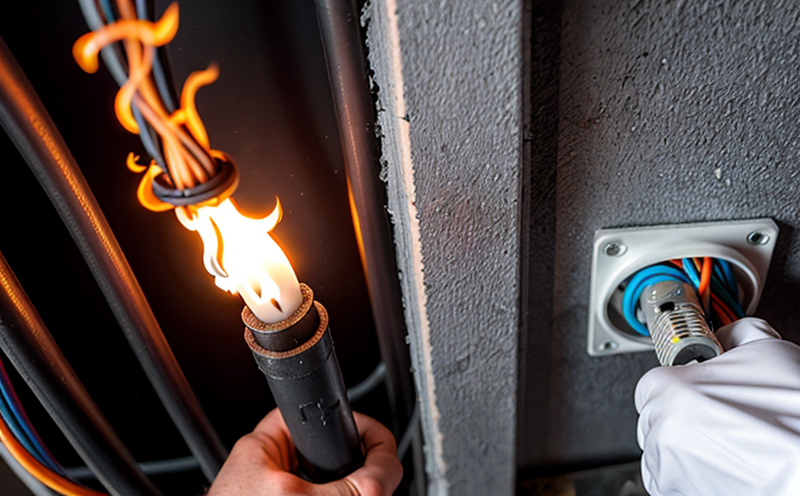ASTM E162 Surface Flammability of Wire Insulation
The ASTM E162 standard provides a method for determining the surface flammability of wire insulation. This test is crucial in ensuring that electrical wiring and cables meet safety standards, particularly those intended for use in environments where fire risk may be heightened due to the presence of combustible materials or high temperatures.
Understanding the surface flammability of wire insulation involves assessing how a sample behaves when exposed to a flame source. ASTM E162 specifies detailed procedures and apparatus that are designed to simulate real-world conditions as closely as possible, thereby ensuring accurate and reliable test results.
The testing process begins with precise preparation of the specimen. The wire or cable under test must be cut into segments of 305 mm (12 inches) in length, with a uniform diameter between 0.64 cm (1/4 inch) and 2.54 cm (1 inch). This ensures that the results are representative of the entire sample.
Once prepared, the specimen is placed on a flat metal support inside a specially designed combustion chamber. The chamber is equipped with an ignition source capable of delivering a standard flame temperature of approximately 760°C (1400°F). The duration of the flame exposure is carefully controlled to ensure consistency across tests.
The primary outcome of the ASTM E162 test is the time it takes for the specimen to ignite and continue burning after the flame source has been removed. This ignition time is a critical parameter that indicates the flammability characteristics of the wire insulation. Additionally, the distance traveled by the flame along the length of the cable or wire provides further insight into its fire resistance properties.
The ASTM E162 test also evaluates the self-extinguishing behavior of the material. After removing the flame source, the specimen should extinguish itself within a specified time frame without requiring any additional intervention. This aspect is particularly important for ensuring that electrical wiring does not contribute to the spread of fire in case of an ignition event.
For quality managers and compliance officers, understanding the ASTM E162 test helps in making informed decisions regarding material selection and design modifications. By adhering to this standard, manufacturers can ensure their products meet stringent safety requirements, thereby reducing potential risks associated with electrical fires.
R&D engineers benefit from familiarity with ASTM E162 as it guides them in developing new materials that not only meet but exceed the specified flammability thresholds. This knowledge is invaluable for innovation and continuous improvement within the industry.
For those involved in procurement, ensuring compliance with standards like ASTM E162 demonstrates a commitment to safety and quality. It also facilitates smoother regulatory processes by providing clear evidence of adherence to international norms.
Why It Matters
The ASTM E162 test plays a pivotal role in safeguarding lives and property by preventing the spread of fires initiated by electrical wiring or cables. By quantifying the flammability properties of wire insulation, this standard helps identify materials that are less likely to contribute to fire hazards.
- Reduces Fire Risks: Ensures that only non-flammable or self-extinguishing insulations are used in critical applications.
- Promotes Safety: Protects workers and end-users from the dangers posed by flammable electrical components.
The results of ASTM E162 testing are widely recognized and accepted, making it easier for manufacturers to comply with local regulations without compromising on quality. This standard also fosters trust among consumers who value product safety.
Environmental and Sustainability Contributions
- Eco-friendly Materials: By promoting the use of non-flammable insulations, ASTM E162 indirectly encourages manufacturers to explore sustainable alternatives that are safer for both people and the environment.
- Reduced Waste: Ensures longer-lasting products reduce the need for frequent replacements, thereby minimizing waste generation throughout the product lifecycle.
The test contributes positively to environmental sustainability by driving innovation towards more resilient materials. This not only enhances fire safety but also supports greener practices in manufacturing and usage.
Competitive Advantage and Market Impact
- Enhanced Reputation: Compliance with ASTM E162 can significantly boost a company’s reputation, attracting more customers who prioritize product safety.
- Innovation Opportunities: By adhering to this standard, companies stay ahead of regulatory changes and market demands, opening up new opportunities for growth.
Compliance with ASTM E162 is increasingly seen as a differentiator in the competitive landscape. It signals to stakeholders that your organization prioritizes safety and quality, setting you apart from competitors who may not meet these standards.





